Medical student: With an aging population, we must rethink our healthcare system

Om Sakhalkar is a medical student at the Medical College of Georgia. He is the President of the American Medical Association – MCG Chapter and a clinic coordinator at the Asian Clinic.
Over 54 million. That’s how many Americans were over the age of 65 in 2019, making up over 15% of the population. Here in Richmond County, we have roughly 30,000 senior citizens. The number of Americans over the age of 65 is projected to accelerate to as many as 80.8 million Americans by 2040 and 94.7 million Americans by 2060, representing an astounding 75% increase in older Americans across a timespan of just 41 years.
The U.S. Department of Health and Human Services Administration for Community Living is responsible for kicking off Older Americans Month every May, with a different theme for each May. This May, the theme is “Age My Way.” The purpose of this year’s theme is to focus on how senior citizens can live independently for as long as possible.
Living independently for as long as possible is a wonderful goal for senior citizens. However, chronic diseases can make this goal difficult if not impossible. The National Council of Aging states that 80% of older Americans have at least one chronic condition, with 68% having two or more chronic conditions. Having so many older Americans with chronic diseases will add strain to our healthcare system and prevent older Americans from living long and fulfilling lives.
More from Om Sakhalkar: Racial health disparities affect us all
The impact of aging goes well beyond senior citizens, placing an enormous burden on our healthcare system. Medicare spending will average an increase of 7.2% annually over this decade, hitting the $1 trillion mark for the first time next year.
Older Americans utilize healthcare services at a far greater rate than the rest of the population. Meanwhile, between physician retirements from the COVID-19 pandemic and older physicians nearing their retirement age, our healthcare shortage is about to become dramatically worse, with a nationwide shortage of 54,100 to 139,000 physicians by 2033.
On top of all this, marginalized minority populations, rural populations and uninsured populations have more barriers to access healthcare, and getting rid of these barriers while also dealing with our aging population could increase the physician shortage to as high as 180,400 physicians.
Increased future demand for healthcare services mixed with fewer physicians will negatively impact our healthcare system. We must rethink our healthcare system to make sure that older Americans are receiving the healthcare they need while also providing healthcare to other Americans and expanding healthcare to those with barriers.
Educating and training more physicians is the best first step. Medical schools in the United States have increased enrollment by 52% from 2002 to 2019. However, the number of residency positions, mandatory training positions after medical school, has remained roughly steady since the late 1990s, rising at an annual rate of only 1%. Increasing the number of residency positions is necessary to increase the number of physicians in the United States.
The American Medical Association (AMA) supports the Resident Physician Shortage Reduction Act of 2021, bipartisan legislation to gradually provide 14,000 new residency positions. We must also do more on emphasizing preventative healthcare services, which have been greatly ignored in the COVID-19 pandemic with record high obesity rates and fewer primary care visits for “nonessential” services.

Providing a 55-year-old counseling for smoking reduces the likelihood of him showing up to the ER when he is 70, whether he has a pulmonary embolism or bladder cancer. We must also try to provide healthcare providers with mental health resources, especially many older physicians who are burned out from the COVID-19 pandemic and want to retire before the traditional retirement. The AMA-endorsed Lorna Breen Health Care Provider Protection Act is a great step to addressing these concerns.
Our population is getting older. The Administration for Community Living’s goal for older Americans to age their way independently is a noble idea, and we must provide older Americans with the doctors and preventative healthcare resources they need to age their way.
This article originally appeared on Augusta Chronicle: American healthcare system must prepare for older, aging population

